Rules
flexiPIM Rules are used to bulk edit products by defining conditions. For example, If you want to
assign selected products to the Black Friday Sale on your e-commerce front, you may do so by creating
a rule based on attributes or family using simple logical conditions. Look out for an example as we
proceed further with the steps.
- How to create a new rule in flexiPIM?
- How to view created Rules in flexiPIM?
- Cloning in flexiPIM?
- Scheduler in flexiPIM?
- Use cases of Rules with Rules Attributes
Rules in flexiPIM are of two types,
Simple Rule- The rule created will be applicable to all products in flexiPIMChannel Based Rules- The rule created will be applicable to products assigned to particular channels.
How to create a new rule in flexiPIM?
Step 1: Login with your credentials
Step 2: Hover over the left sidebar on the flexiPIM dashboard to access the
'Associations' menu.
Step 3: Click on 'Associations' to expand, then click 'Rules'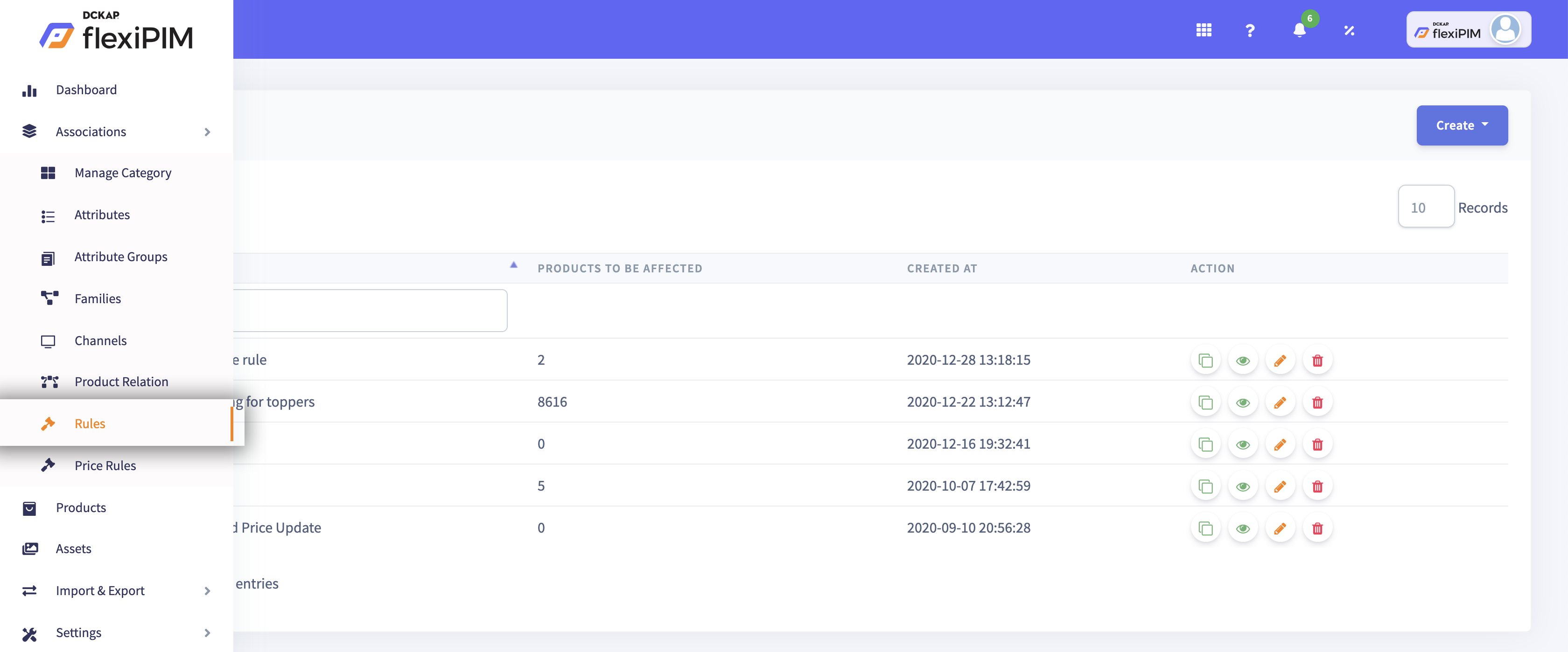
Step 4: On top right corner of the table, click the 'Create' button. A drop-down menu
appears, choose the type of rule you wish to create, either Simple or Channel
based.
Step 5: The 'Create Rule' page appears.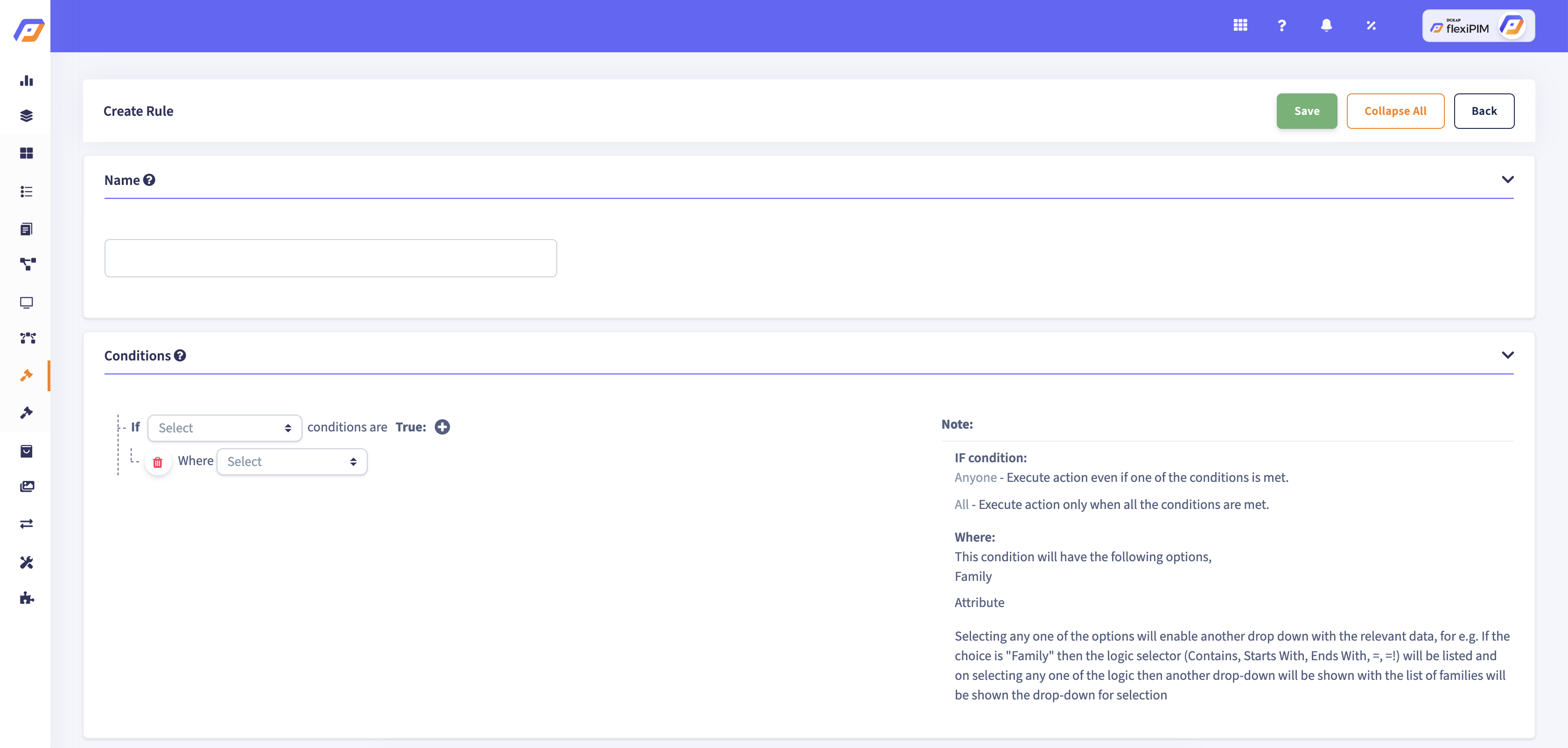
Rule creation has four sections,
- Name
- Conditions
- Actions
- Events & Scheduler
Name
Enter a unique name as an identity for the rule to be created.

Conditions
Conditions are used to specify the conditions for rules.

- In the first line, you will find a dropdown with values,
AnyoneandAll. - To create rules which satisfy all your conditions choose
All. - To create rules which meet any one of the conditions, select
Anyone. - Click on the Plus
(+)symbol to add conditions. A new row is added where you can choose the conditions.
For example, If All Conditions are True (+) Where Family = Clothing as shown below is the
condition statement.
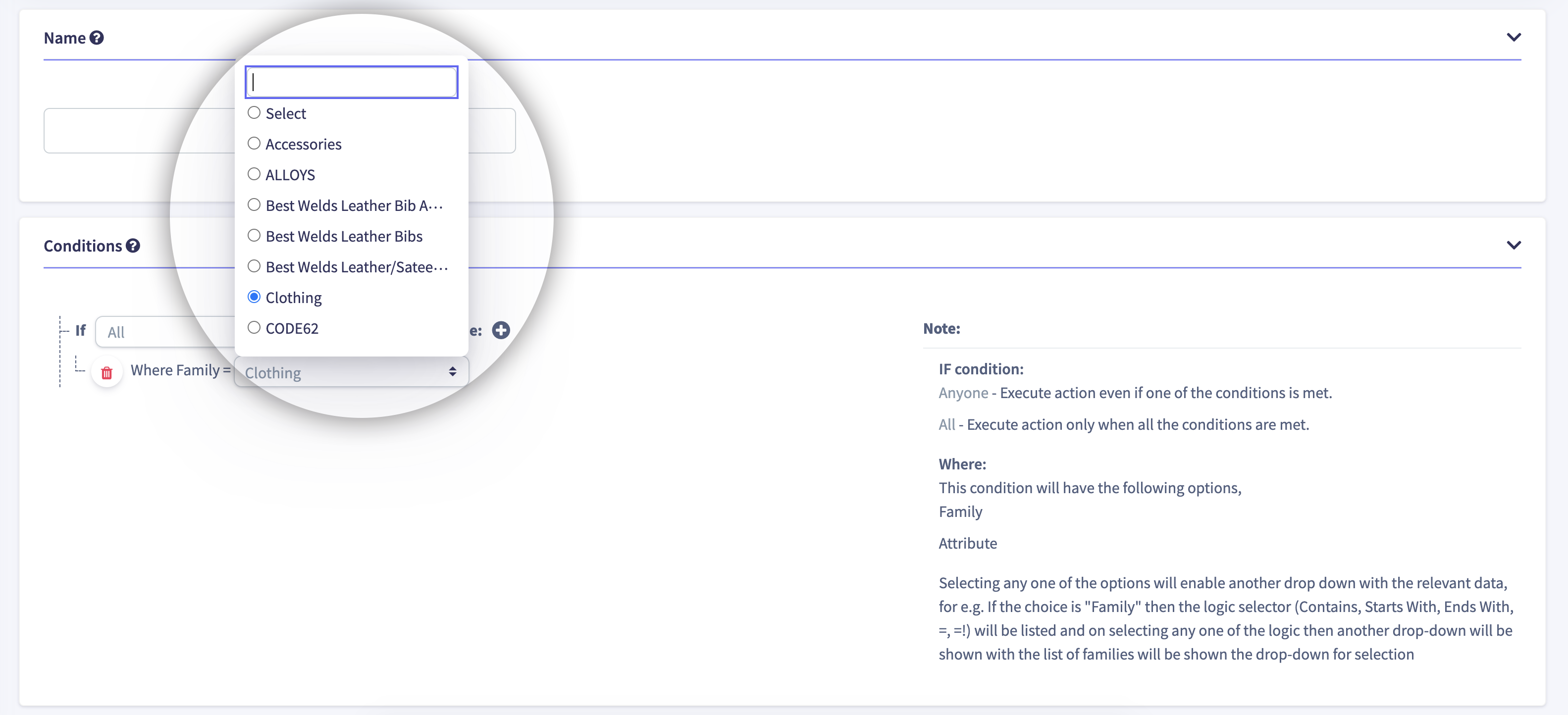
Actions
Actions are used to create actions for the given conditions. Like conditions, you can add any number of actions. The images below show an example of the stepwise creation of actions.
| Step 1 | Step 2 | Step 3 |
|---|---|---|
 |
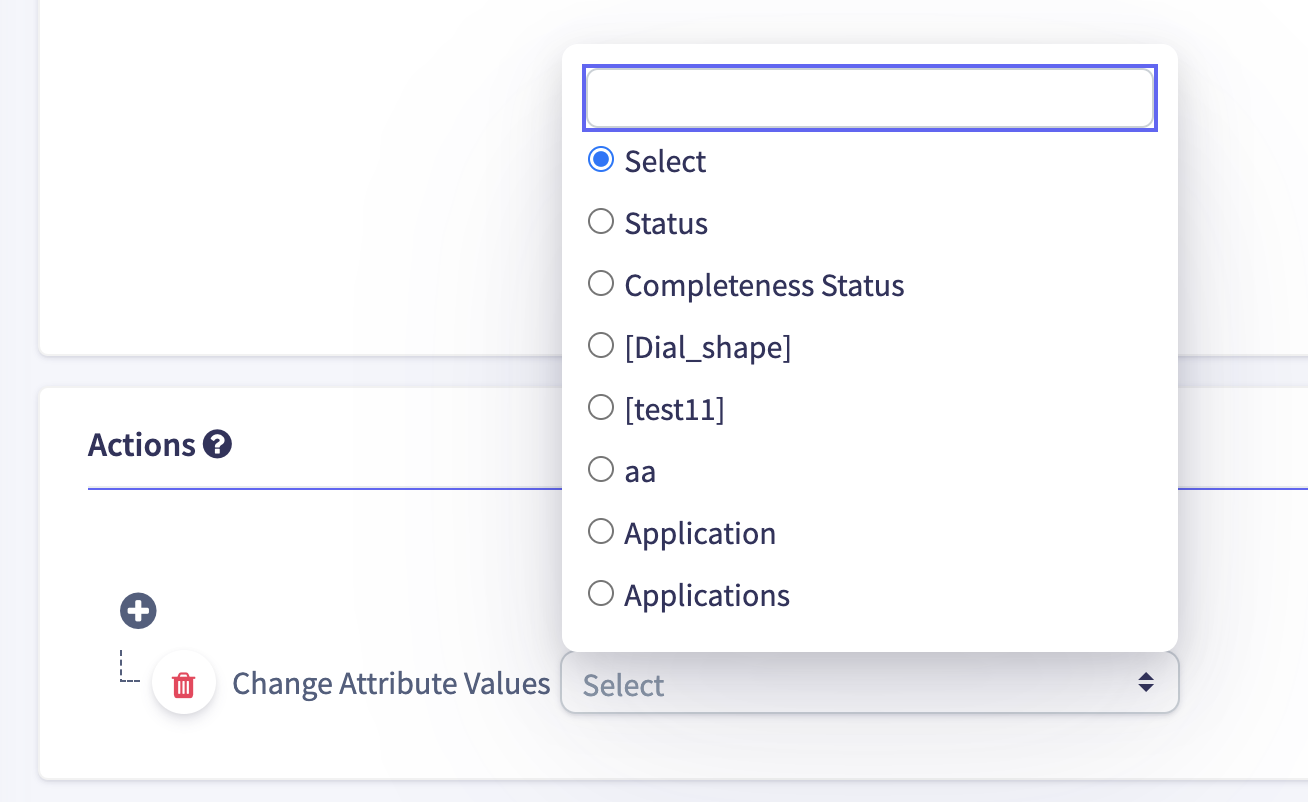 |
 |
The creation of actions can have n number of permutations and combinations based on the conditions and the action you want to perform.
Events & Scheduler
Events & Scheduler allows you to automate rules whenever an event occurs. Select the event from the drop-down list as shown below.
For example, When you choose Product Update Event from the dropdown, the aforementioned
actions will occur whenever a Product Update occurs.

Step 6: Enter the required fields
Step 7: Click on the 'Save' buttonHow to view created Rules in flexiPIM?
Step 1: Once 'Rules' are created, they will be listed in the rules table view.
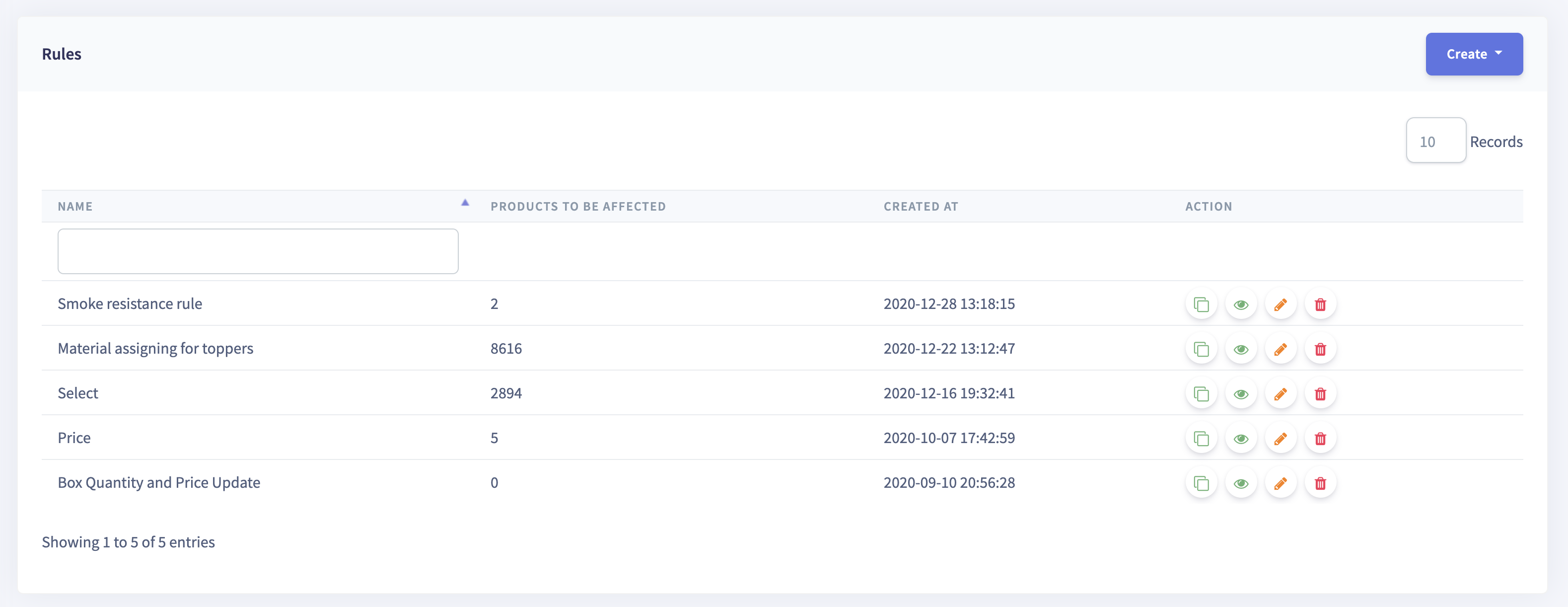
Step 2: Click on the 'Eye' icon to view a rule in detail.

Step 3: From the rules preview page, you can execute rules by clicking
on the 'Execute' button on the top right of the page. If the
rule is currently running, this button will be disabled until the rule
execution completes.
Step 4: In the affected Product section, you can find a list of products
affected by executing rules. In the log page, you can find a log
of rules executed in the past.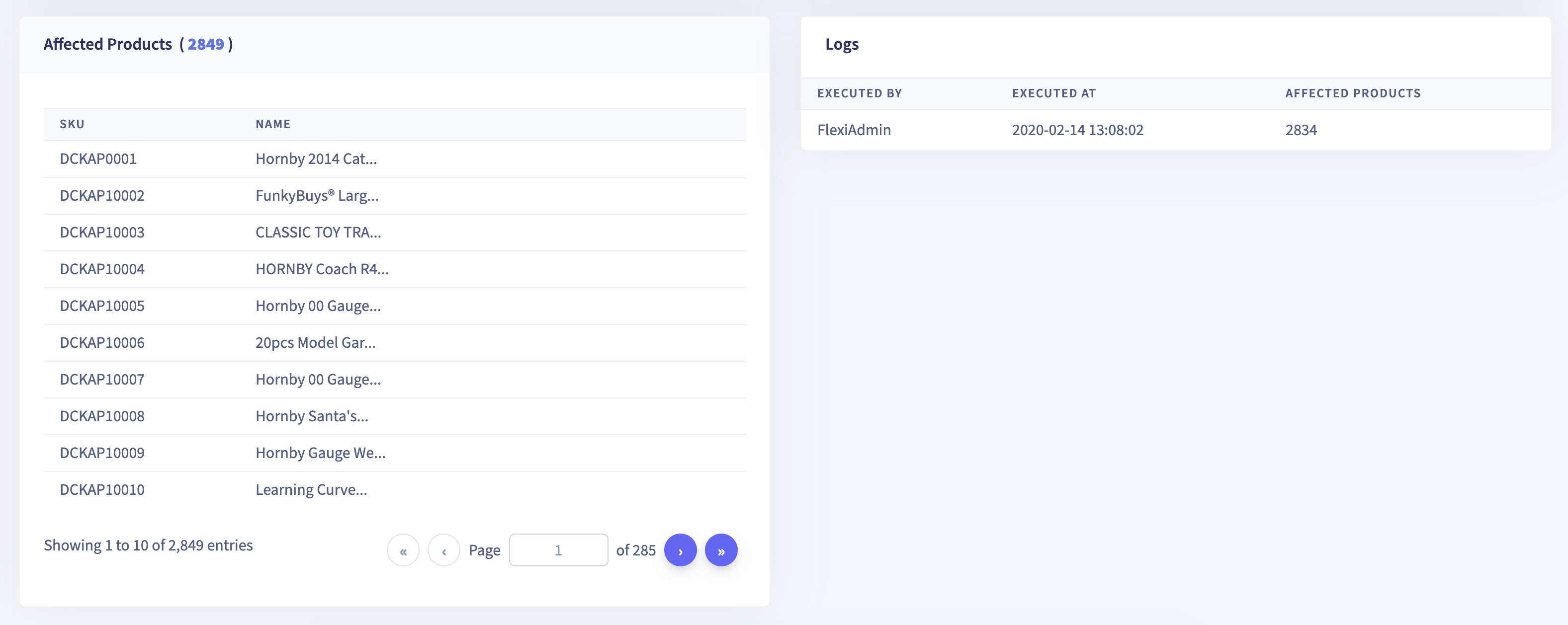

Cloning in flexiPIM?
Duplicate a rule using this feature from the Rules page. This comes in handy when you want to create two similar rules with a few additions or deletions in them.
- Navigate to
Rulesfrom the left side bar in flexiPIM - Click on the Clone icon from the table as shown in the image below
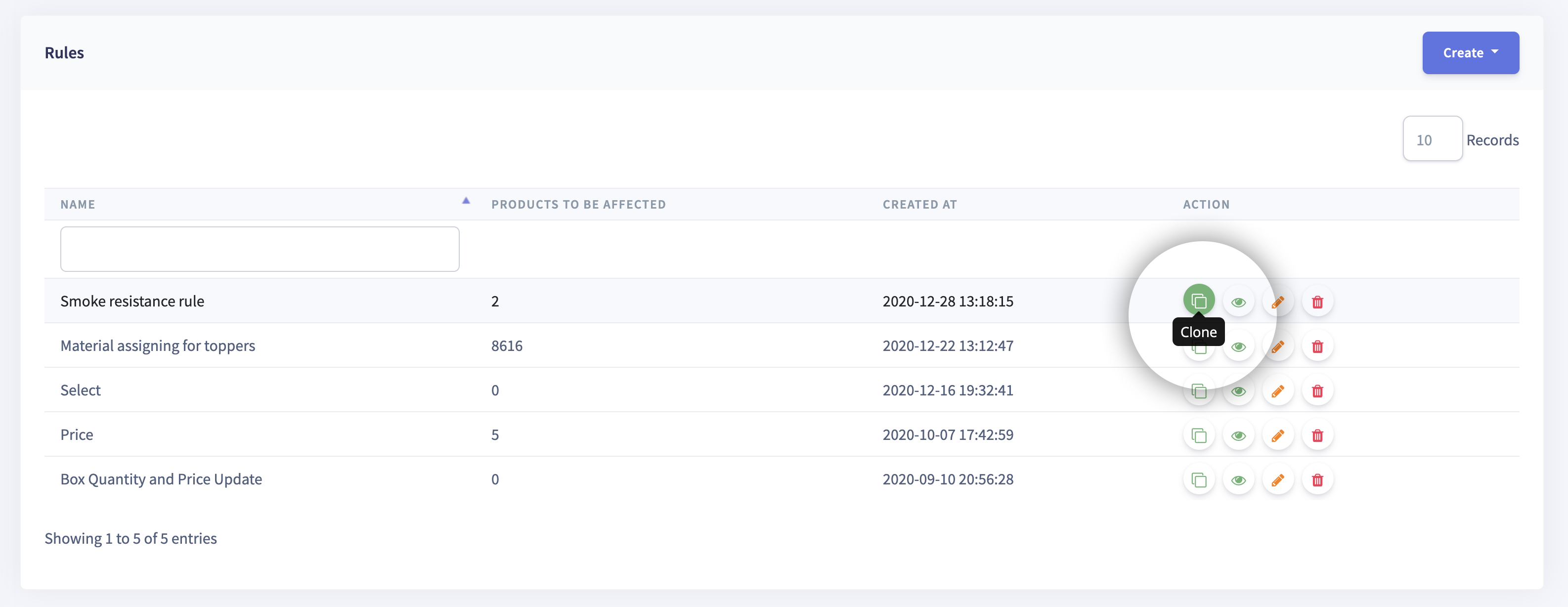
- A popup appears where you can rename the rule that you wish to duplicate.

- A duplicate rule is now created and ready to be edited from the tabular view.
Scheduler in flexiPIM?
A rule scheduler helps you set the frequency of running a rule. It comes in handy when you wish to run a rule at regular intervals of time.
- Navigate to
Rulesfrom the left side bar in flexiPIM - Click on the
pencilicon from the table as shown in the image below
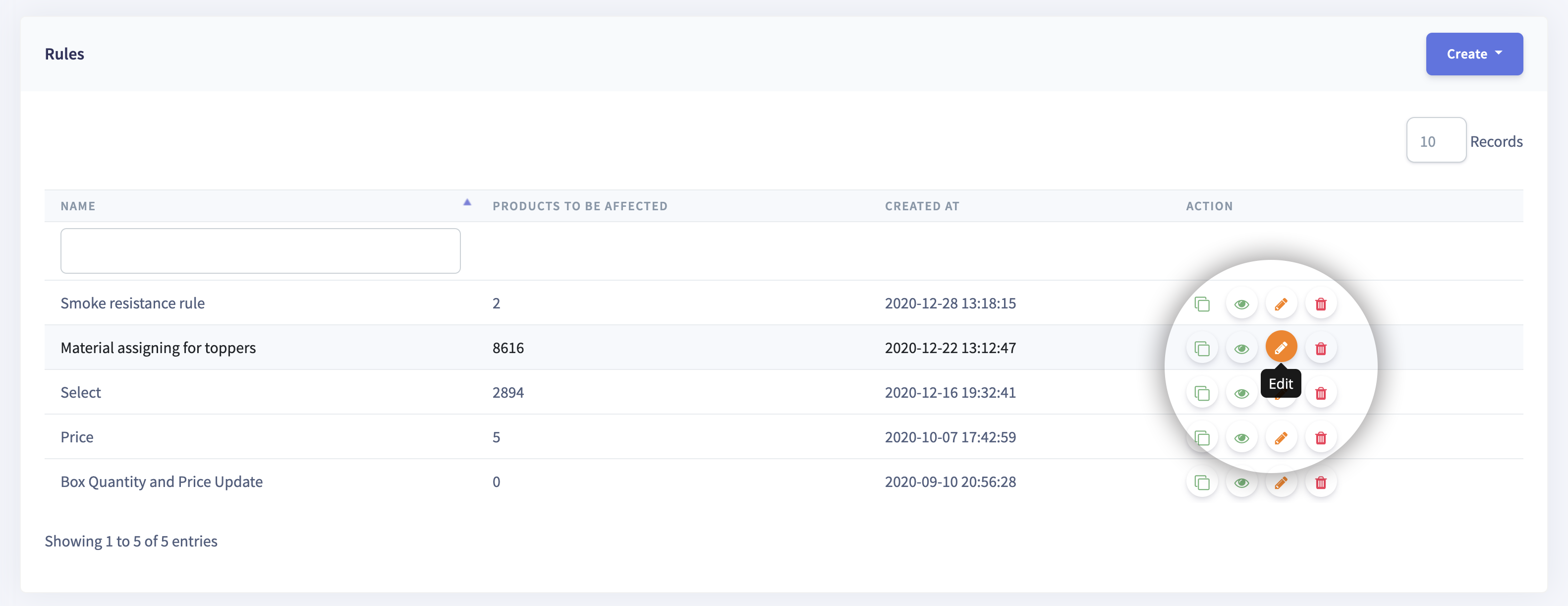
- Click on
Scheduleras shown below and you will see a drop-down menu with options like an nth minute, hour, day, week, and so on from which you can choose the desired frequency of running a rule.

Use cases of Rules with Rules Attributes
Rules help you to perform bulk actions using preset conditions and actions. You can assign conditions based on product attributes like number, text, text area, and so on within flexiPIM.
Number
Assign conditions for the products holding the number attribute. Below is an example of executing a rule based on the number attribute.
Step 1: In this example, you are executing a rule to change the 'Completeness status'
of products that have weight in between 1 to 200 (where 1 and 200 are included)
to 'Ready.'
Step 2: Refer to 'How to create a new rule' on this page for step by step procedure.
Step 3: You will have the following options to select for a 'Number attribute' -
'BigCommerce weight' in this case.

Using 1 and 10 for example,
| Actions | Description |
|---|---|
| Equal to = | Attribute value equal to 1 |
| Not equal to != | Attribute value not equal to 1 |
| Lesser than < | Attribute value lesser than 10. Excludes the number 10. |
| Lesser than or equal to <= | Attribute value lesser than or equal to 10. Includes the number 10. |
| Greater than > | Attribute value greater than 10. Excludes the number 10 |
| Greater than or equal to >= | Attribute value more than or equal to 10. Includes the number 10 |
| In between | Attribute values in between two numbers say 1 and 10. Includes 1 and 10. |
| Not in between | Attributes values other than those between two given numbers. |
| Is Null | The attribute value is empty |
Step 4: Assign the conditions and actions as shown below and click on 'Save'.

Step 5: On the 'Rules' main page, click on view to see the details as shown below.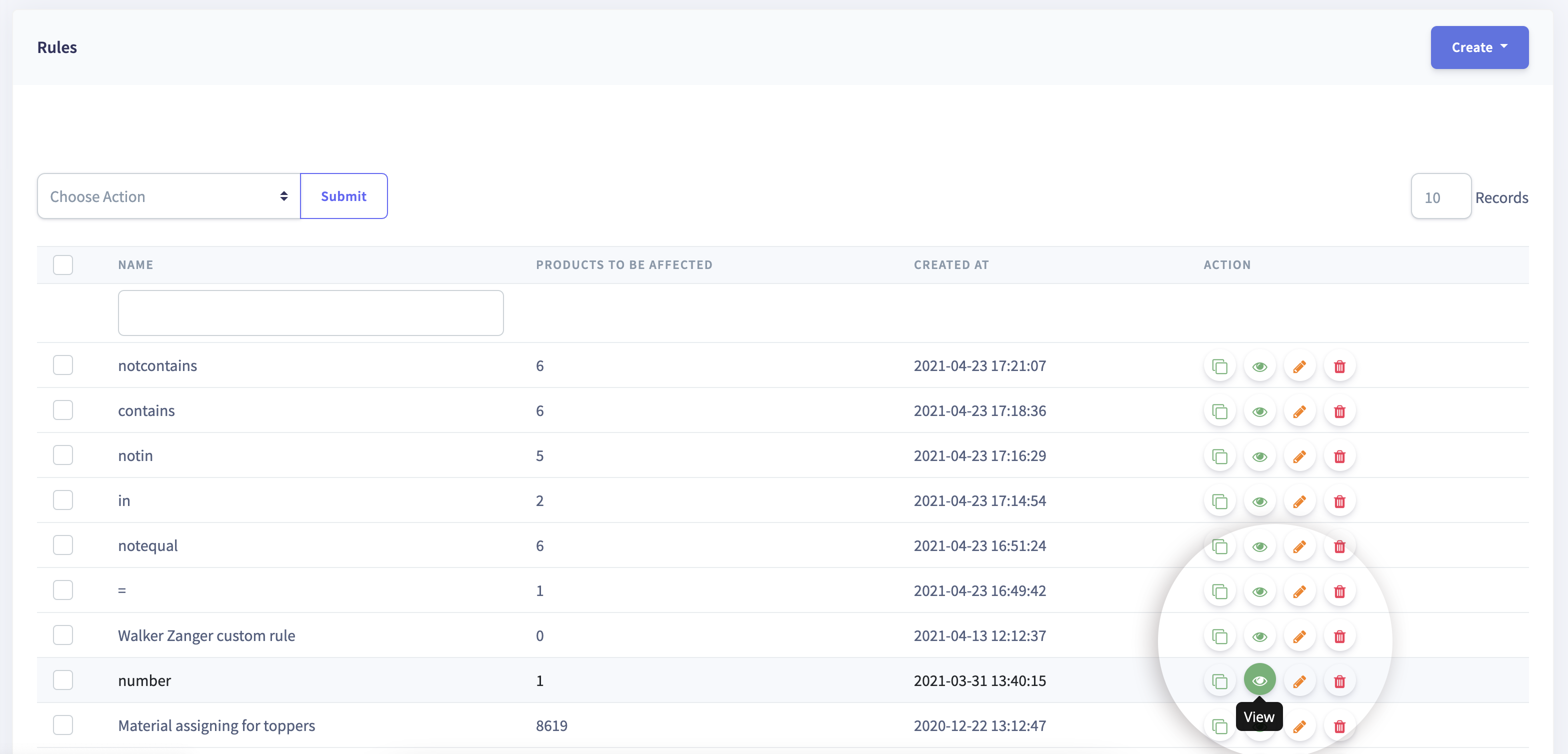
Step 6: You will see the list of products affected by this rule. Click on execute and
the rule gets applied to the list of products.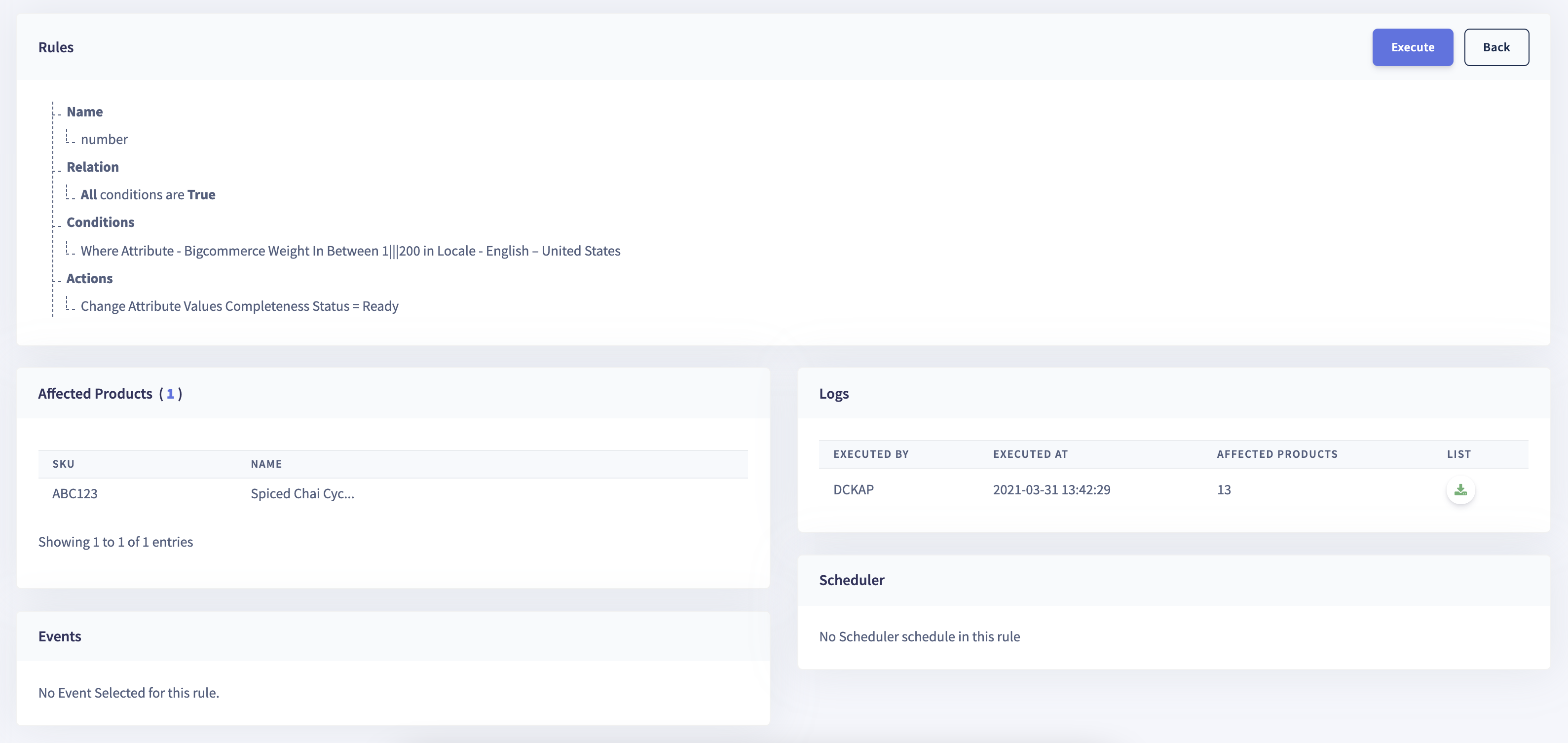
Step 7: On the 'Products' page you can see the changes affected by the rule. You can
also view the changes by clicking on the pencil icon corresponding to the product.
Text attribute
The procedure for executing rules is the same for all attributes. Here are the values using which you can set rules based on the text attribute.

{info}
Note:The attribute values are not case sensitive. You can set rules by attribute values using full or partial words (For eg, available or avai or a).
Using Avai as the text attribute value for example,
| Actions | Description |
|---|---|
| Equal to = | Attribute value same as Avai |
| Not equal to != | Text field value not same as Avai |
| Contains | Text field value containing Avai |
| Start with | Text field value starting with Avai |
| End with | Text field value ending with Avai |
| Is null | The text field value is empty |
| Not contains | Text field values that do not contain the word Avai |
Text Area/Rich text attribute
Text area attribute is similar to text attribute but only used for phrases, longer text, or descriptions. The attribute values for this attribute are the same as those for text attributes.
Using Available as the text attribute value for example,
| Actions | Description |
|---|---|
| Equal to = | Text area same as Available |
| Not equal to != | Text area not same as Available |
| Contains | Text area containing Available |
| Start with | Text area starting with Available |
| End with | Text area ending with Available |
| Is null | The text field value is empty |
| Not contains | Text areas that do not contain the word Available |
Multi-Select
Assign conditions for products holding the multi-select attributes. Take a look at the example below. The procedure to execute a rule remains the same as in the previous examples.
This a list of products holding the multi-select attribute- Multiple Colour Options
with different color options in them.
- Product 1 - Red, Green, Blue
- Product 2 - Red, Blue
- Product 3 - Green, Blue
- Product 4 - Red, Green
- Product 5 - Red
- Product 6 - Blue
- Product 7 - Yellow, Green, Blue
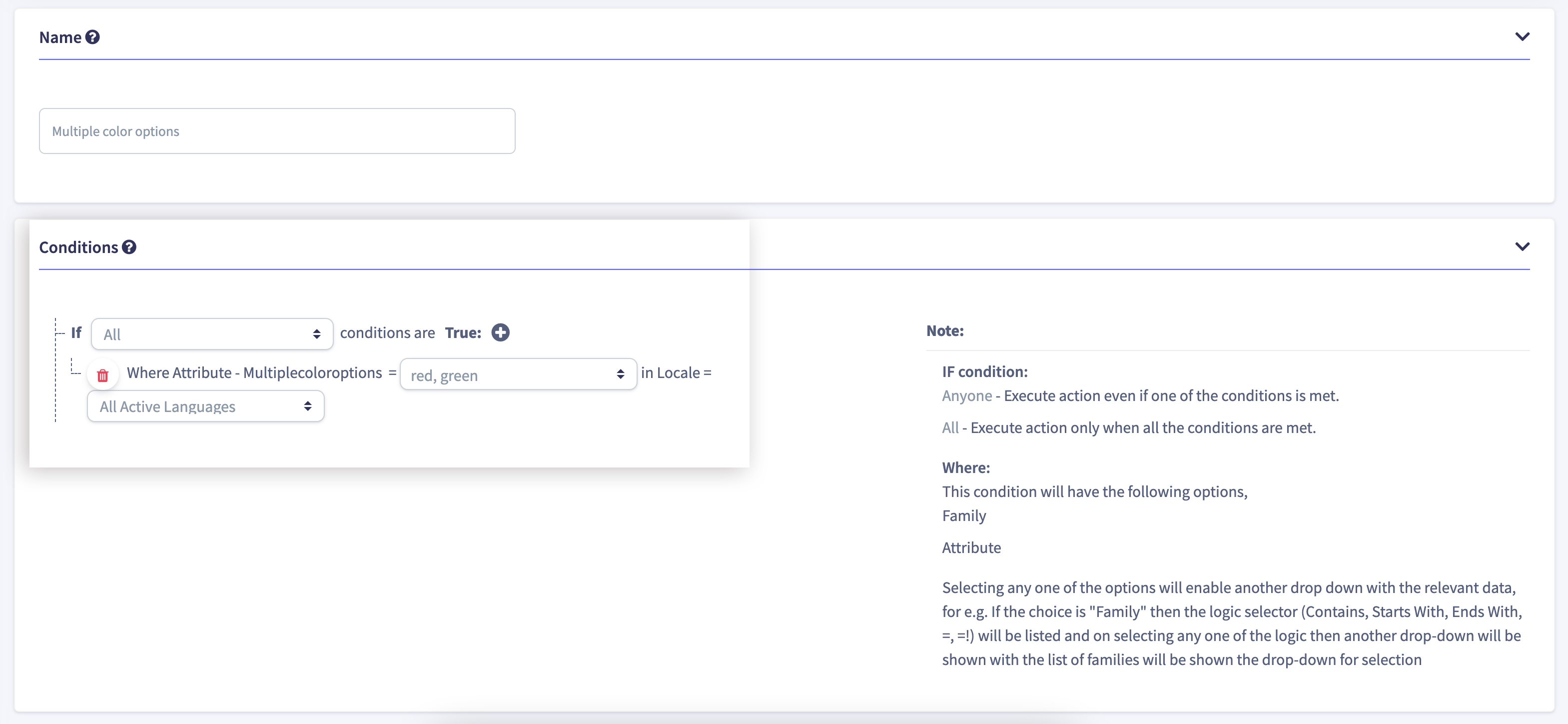
Condition - Red, Green
| Actions | Description |
|---|---|
| Equal | Products having only the values Red and Green will be affected. In this case Product 4 |
| Not Equal | Products having only the values Red and Green will be affected. Product 4 Products, not containing the exact values Red and Green will be affected. In this case Product 1,2,3,5,6,7 |
| In | Products that have both values Red and Green will be affected. In this case, Product 1,4 |
| Not In | Products that do not have Red and Green as a combination will be affected. Product 2,3,5,6,7 |
| Contain | Products that have either one of the values Red or Green will be affected. Product 1,2,3,4,5,7 |
| Not Contain | Products that contain even one of the values Red or Green will NOT be affected. Product 6. |
| Is Null | Products that do not contain any multi-select values will be affected. |